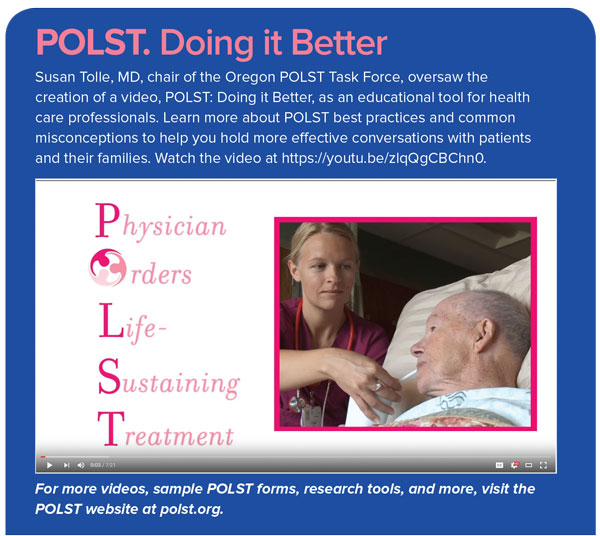It is 9 a.m. in the emergency department when triage announces overhead, “Cardiac arrest. 5 minutes.” A few minutes later, the EMS crew arrives actively doing CPR. “This is Mrs. Smith, a 92-year-old found down by family.” Mrs. Smith is small, and her frail chest crumples under the weight of the compressions. Her two distraught daughters arrive shortly thereafter. After updating them on the situation, one daughter cries out, “I want you to do everything. Don't stop. I can't lose my mom!” The other sister softly responds, “I don't think she would want any of this. She knew her health was bad and had talked to her doctor and me about it.” From her purse she pulls out a bright pink form.
This situation is not uncommon. We, as emergency physicians, are frequently charged with caring for patients without knowing whether the treatment being provided is in line with their wishes and beliefs. Many patients at the end of life choose to forego burdensome treatments that do not add to their comfort.1 Unfortunately, in the past, there was not a standard way to document these wishes, so families were left guessing what their loved one would want. Thankfully there is now a way for patients to communicate their end of life wishes even when they are unable to speak for themselves: the Physician Orders for Life Sustaining Treatment (POLST).
What is POLST?
The POLST is a set of medical orders that communicate a patient's wishes for his/her care and helps to guide physicians in their medical management.1 This form helps to avoid treatments that are against a person's goals of care. Most states have or are working on a version of the POLST, which is called by many names, including MOLST, MOST, or POST forms.
The POLST is preferred over advance care directives and offers many improvements, such as:2
- Eliminates complicated legal wording found in advance care directives.
- Recognizes that the status of a medically complex patient is rarely simply “brain dead.”
- Is classified as physician orders, so they can be legally followed by EMTs and are applicable in all health care settings, including the patient's home.
The hope is that these benefits and increased provider discussions, encouraged by Medicare now reimbursing for these discussions, will increase participation with the POLST.3
It is important for emergency physicians to become familiar with their own state's form. In general the form is divided into 4 areas:
- CPR. The patient must indicate whether they want cardiopulmonary resuscitation.
- Medical interventions. If the patient has a pulse and is breathing, would s/he want comfort measures only, limited treatment, or full treatment?
-
- Comfort measures are any medications, wound care, antibiotics, or other treatments that focus on the patient's comfort.
- Limited treatment includes comfort measures as well as bilevel positive pressure ventilation, but it avoids intubation or admission to the intensive care unit.
- Full treatment includes intubation, mechanical ventilation, and defibrillation.
- Artificial nutrition. The patient indicates a preference for no artificial nutrition, a limited time with nutrition provided by a tube, or long-term artificial nutrition.
- Signatures. The form requires the patient's or the patient's health care representative's signature, as well as that of a physician.
The direction of providing care in the emergency department is changing from action first to determination of patients' wishes at the onset of care.3 One of the first questions we as emergency physicians should ask when a critically ill patient presents to the ED is, “Do they have a POLST?”
Completing a POLST form with a patient is also within the realm of care for emergency providers. It is often helpful to start the conversation with, “What is important to you?” or “What do you understand about your disease?” Emergency providers must not overlook comfort care as an option and should also inform the family that comfort care with aggressive symptom management is a treatment option.

Case Resolution
Mrs. Smith had a signed POLST form that clearly stated her wishes. She wanted comfort measures only, so CPR was ceased, and Mrs. Smith died with her daughters at bedside. Both were comforted by the fact that Mrs. Smith had made her own decision and directed her own care.
For more information about programs in your state, visit The National POLST website: http://www.polst.org/programs-in-your-state.
References
- What is POLST? National POLST. polst.org/about-the-national-polst-paradigm/what-is-polst/
- Bomba PA, Kemp M, Black JS. POLST: An improvement over traditional advance directives. Cleve Clin J Med. 2012;79(7):457-464.
- Aberger K. Chair, Palliative Medicine Section of ACEP. Information obtained from email communication, March 2016.



